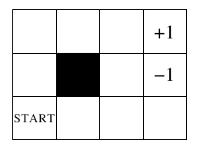The world looks like this:

The agent starts in the bottom left corner and has to reach the top right corner. We use a coordinate system (0,0) in the starting state and (3,2) in the goal state.
Due date: Monday March 3 2014
We use a Grid World introduced by Parr and
Russell to evaluate the behavior of an agent in a stochastic
partially-observable domain. Robotic domains are usually both
stochastic (because actions may fail and lead to several different
outcomes), and partially-observable (because the robot sees the
world through it's sensors, and can always see only a portion of
it).
The world looks like this:

The agent starts in the bottom left corner and has to reach the
top right corner. We use a coordinate system (0,0) in the starting
state and (3,2) in the goal state.
Actions: the actions available to the agent in the plan
are ActMove_N, ActMove_E, ActMove_S, and ActMove_W.
Perceptions: the agent can perceive whether or not there is
an obstacle in the square that is immediately east and west from
it. There are four possible combinations: no obstacle on east and
no obstacle on west, obstacle on east but not obstacle on west, no
obstacle on east but obstacle on west, obstacle on both sides.
These for conditions are represented by the following four atomic
conditions which can be used in the plan: LF_RF, LF_RO,
LO_RF, LO_RO. Furthermore, the agent can perceive whether or not
it is in a final state, testing the atomic condition FinalState.
Both (3,2) and (3,1) are final states.
Transitions: when an agent chooses an action and perform
it, the environment transitions to the next state. We will
consider two version of the transitions, one is deterministic,
while the other one is stochastic. With deterministic
transitions actions always succeed. Therefore, if an agent perform
the action ActMove_N it will always move one step north, unless
there is an obstacle in that direction, in which case it will stay
put. With stochastic transitions, however, each action has 0.8
probability of success and a 0.1 probability of moving the agent
towards one of two orthogonal directions. Therefore, if the agent
performs the actions ActMove_N it will move one step north with
probability 0.8, one step east with probability 0.1, and one step
west with probability 0.1. After having determined the direction,
if there is an obstacle in that direction the agent stays put.
Cost: Each action costs the agent 1/MAX_N where MAX_N is
the maximum number of actions allowed. In our implementation MAX_N
= 30. Reaching the goal state (3,2) rewards this agent with a +1,
while reaching the state (3,1) penalizes the agent by -1. Note
that (3,1) is also a terminal state, so once the agent ends up
there there is no way out. For instance, if an agent reaches the
goal in 7 steps, it's total reward will be 1 (for the goal) - 7/30
= 0.7666. If the agent ends up in the trap (3,1) in 4 steps its
reward is -1 - 4/30 = -1.1333. The maximum possible reward is
obtained by reaching the goal in 5 steps and is 1 - 5/30 =
0.83333. The worst possible reward is obtained by reaching the
trap in 30 steps (the maximum number of steps) and is -2.
The software you need is:
pnp.zip - PNP Library. We have covered in
class how to compile it and set the environment variables
PNP_INCLUDE and PNP_LIB. Generate the documentation with doxygen
to see a quick reference guide on how to use PNP with your domain.
gridworlds.zip - an implementation
of the domain described above.
helloworld.zip - an implementation of a simple hello world plan, that you can use as an example of the classes you need to implement to connect PNP to a given domain.
ultrajarp.zip - the editor for plans.
The main file in gridworld has a couple parameters you can set:
Write a plan for the deterministic version of the domain, that is assuming that the actions always succeed.
Create two ROS nodes, one that wraps PNP, and the other one that
runs Gridworld.